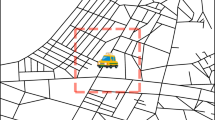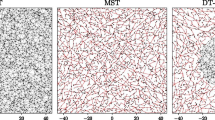Abstract
We study the impact of disruptions on traffic networks, and the relaxation of the system after the removal of the disruption. We model the steady-state density along the disrupted route using a simple phenomenological model. We then combine this model with domain wall theory to analyze the transient behavior of the system. We compare the predictions produced by these macroscopic models with simulations of a stochastic cellular automaton model.
Access this chapter
Tax calculation will be finalised at checkout
Purchases are for personal use only
Preview
Unable to display preview. Download preview PDF.
Similar content being viewed by others
References
Diedrich, G., Santen, L., Schadschneider, A., Zittartz, J.: Effects of on- and off-ramps in cellular automata models for traffic flow. International Journal of Modern Physics C 11(3), 519–529 (2002)
Ebersbach, A., Schneider, J.J.: Two-lane traffic with places of obstruction to traffic. International Journal of Modern Physics C 15, 535–544 (2004)
de Gier, J., Garoni, T.M., Rojas, O.: Traffic flow on realistic road networks with adaptive traffic lights. Journal of Statistical Mechanics: Theory and Experiment 2011, P04008 (2011)
Hanaura, H., Nagatani, T., Tanaka, K.: Jam formation in traffic flow on a highway with some slowdown sections. Physica A: Statistical Mechanics and its Applications 374, 419–430 (2007)
Ishibashi, Y., Fukui, M.: The bottleneck effect on high-speed car traffic. Journal of the Physical Society of Japan 70, 1237–1239 (2001)
Janowsky, S.A., Lebowitz, J.L.: Finite-size effects and shock fluctuations in the asymmetric simple-exclusion process. Physical Review A 45, 618–625 (1992)
Janowsky, S.A., Lebowitz, J.L.: Exact results for the asymmetric simple exclusion process with a blockage. Journal of Statistical Physics 77, 35–51 (1994)
Jia, B., Jiang, R., Wu, Q.S.: The traffic bottleneck effects caused by the lane closing in the cellular automata model. International Journal of Modern Physics C 14, 1295–1303 (2003)
Kolomeisky, A.B.: Asymmetric simple exclusion model with local inhomogeneity. Journal of Physics A: Mathematical and General 31, 1153–1164 (1998)
Kolomeisky, A.B., Schutz, G.M., Kolomeisky, E.B., Straley, J.P.: Phase diagram of one-dimensional driven lattice gases with open boundaries. Journal of Physics A: Mathematical and General 31, 6911–6919 (1998)
Komada, K., Masukura, S., Nagatani, T.: Effect of gravitational force upon traffic flow with gradients. Physica A 388, 2880–2894 (2009)
Nagai, R., Hanaura, H., Tanaka, K., Nagatani, T.: Discontinuity at edge of traffic jam induced by slowdown. Physica A: Statistical Mechanics and its Applications 364, 464–472 (2006)
Nagel, K., Schreckenberg, M.: A cellular automaton model for freeway traffic. Journal de Physique I 2, 2221–2229 (1992)
Santen, L., Appert, C.: The asymmetric exclusion process revisited: Fluctuations and dynamics in the domain wall picture. Journal of Statistical Physics 106, 187–199 (2002)
Tanaka, K., Nagai, R., Nagatani, T.: Traffic jam and discontinuity induced by slowdown in two-stage optimal-velocity model. Physica A: Statistical Mechanics and its Applications 370, 756–768 (2006)
Zhang, J., Li, X., Wang, R., Sun, X., Cui, X.: Traffic bottleneck characteristics caused by the reduction of lanes in an optimal velocity model. Physica A 391, 2381–2389 (2012)
Zhang, L., de Gier, J., Garoni, T.M.: Traffic disruption and recovery in road networks. Physica A: Statistical Mechanics and its Applications 401, 82–102 (2014)
Author information
Authors and Affiliations
Editor information
Editors and Affiliations
Rights and permissions
Copyright information
© 2014 Springer International Publishing Switzerland
About this paper
Cite this paper
Zhang, L., Garoni, T.M. (2014). Modeling Disruption and Recovery of Traffic in Road Networks. In: Wąs, J., Sirakoulis, G.C., Bandini, S. (eds) Cellular Automata. ACRI 2014. Lecture Notes in Computer Science, vol 8751. Springer, Cham. https://doi.org/10.1007/978-3-319-11520-7_68
Download citation
DOI: https://doi.org/10.1007/978-3-319-11520-7_68
Publisher Name: Springer, Cham
Print ISBN: 978-3-319-11519-1
Online ISBN: 978-3-319-11520-7
eBook Packages: Computer ScienceComputer Science (R0)




